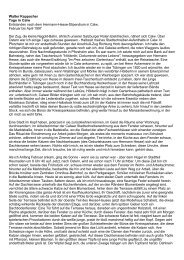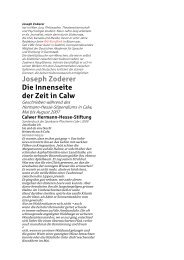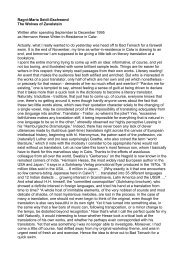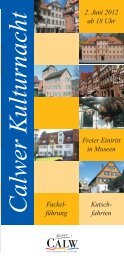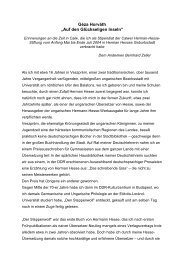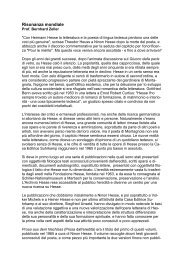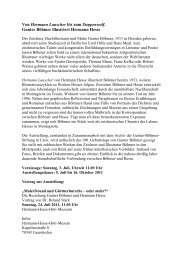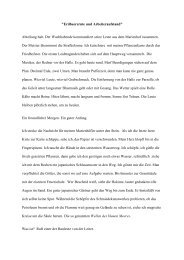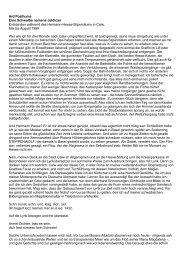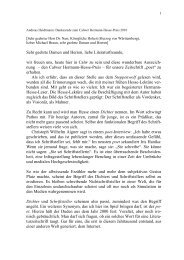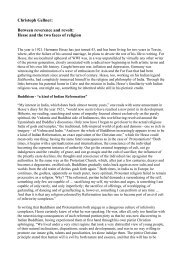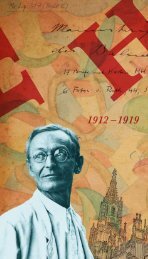Wulf Kirsten Talking to the water ouzel Written after spending May to ...
Wulf Kirsten Talking to the water ouzel Written after spending May to ...
Wulf Kirsten Talking to the water ouzel Written after spending May to ...
Create successful ePaper yourself
Turn your PDF publications into a flip-book with our unique Google optimized e-Paper software.
<strong>Wulf</strong> <strong>Kirsten</strong><br />
<strong>Talking</strong> <strong>to</strong> <strong>the</strong> <strong>water</strong> <strong>ouzel</strong><br />
<strong>Written</strong> <strong>after</strong> <strong>spending</strong> <strong>May</strong> <strong>to</strong> August 1996<br />
as Hermann Hesse Writer-In-Residence in Calw.<br />
Right slap bang in <strong>the</strong> middle of an industrious little <strong>to</strong>wn that prides itself on<br />
occasions at which brass-band music creates an uplifting mood of general<br />
exuberance. And when brass-band music does not happen <strong>to</strong> be on <strong>the</strong> menu, daily<br />
life on <strong>the</strong> modest little main boulevard is alive with a<strong>to</strong>nal concert pieces for Bosch<br />
hammer, s<strong>to</strong>ne saw, car radio, and souped-up mo<strong>to</strong>rbike. The buskers on <strong>the</strong> street<br />
find it hard <strong>to</strong> compete with such a cacophony. They have <strong>to</strong> seek out a quieter hour<br />
in order <strong>to</strong> show that <strong>the</strong>y, <strong>to</strong>o, can communicate with <strong>the</strong> <strong>to</strong>wn. And, should <strong>the</strong>y not<br />
be on hand, <strong>the</strong>n - last but not least - it is <strong>the</strong> turn of a pious singer unable <strong>to</strong> tear<br />
himself away from his confirmation suit who is joined by a sidekick handing out liberal<br />
volumes of tracts <strong>to</strong> people hungry <strong>to</strong> believe. The city <strong>to</strong>wers have been replaced by<br />
peripatetic watch<strong>to</strong>wers. And, in <strong>the</strong> event that a pause in <strong>the</strong> constant noise does<br />
perhaps occur, one of <strong>the</strong> hawkers under my corner window intent on boosting sales<br />
will know how <strong>to</strong> charm canned signature tunes from some device or o<strong>the</strong>r. A delight<br />
taken in opportunities <strong>to</strong> <strong>to</strong>otle and in<strong>to</strong>ne that simply never ceases. It is this that<br />
assures <strong>the</strong> little <strong>to</strong>wn of its remarkable dynamism and liveliness. As if it were unable<br />
<strong>to</strong> endure <strong>the</strong> silence, it has <strong>to</strong> deafen and suffocate itself with catchy little tunes and<br />
jingles.<br />
Raised up here <strong>to</strong> a lofty position in an attic flat rich in views, revealing <strong>the</strong> full beauty<br />
of some of <strong>the</strong> hills and mountains surrounding <strong>the</strong> <strong>to</strong>wn, over which I can run my eye<br />
at will - providing <strong>the</strong>re is no fog, no rainy haze hanging over <strong>the</strong> valley. The foothills<br />
of <strong>the</strong> mountains, tangled and tripping over one ano<strong>the</strong>r in <strong>the</strong>ir narrow quadrate,<br />
squeeze <strong>the</strong> <strong>to</strong>wn <strong>to</strong>ge<strong>the</strong>r, making <strong>the</strong> gables pointed and narrow-chested, piling <strong>the</strong><br />
houses on <strong>to</strong>p of one ano<strong>the</strong>r like boxes. Returning from one of <strong>the</strong> elevations high<br />
above - where a fresh breeze is always caressing <strong>the</strong> back of <strong>the</strong> mountains - and<br />
tumbling down back in<strong>to</strong> <strong>the</strong> <strong>to</strong>wn, floor by floor, one has <strong>the</strong> scary feeling that one<br />
will never reach <strong>the</strong> bot<strong>to</strong>m, until, suddenly, one sees <strong>the</strong> church <strong>to</strong>wer rising up out<br />
of <strong>the</strong> jumble of roofs, and is relieved not <strong>to</strong> be falling in<strong>to</strong> a bot<strong>to</strong>mless abyss.<br />
Sunday morning, sitting at <strong>the</strong> open window, watching <strong>the</strong> summer clouds billow up<br />
over <strong>the</strong> mountain ridges, in <strong>the</strong> midst of a babble of voices speaking unknown<br />
languages that penetrates up <strong>to</strong> me in a manner so unabashedly vibrant with life and<br />
keen <strong>to</strong> saunter <strong>the</strong> streets as if it was seeking <strong>to</strong> transport me <strong>to</strong> some oriental<br />
outpost. And, once again, a hail of drum-rolls hits <strong>the</strong> typewriter, which only<br />
reluctantly yields up <strong>to</strong> <strong>the</strong> sentences being hammered in<strong>to</strong> it.<br />
Each stroll through <strong>to</strong>wn, each jaunt out in<strong>to</strong> <strong>the</strong> surrounding vales, gorges and<br />
depressions that notch <strong>the</strong> declivities of <strong>the</strong> Black Forest terrain, can be savoured<br />
long <strong>after</strong> <strong>the</strong> event, and can be unreeled in front of one’s eyes like a film. The stroll<br />
across <strong>the</strong> marketplace on Saturday morning has <strong>to</strong> be repeated several times before<br />
<strong>the</strong> turbulences have been internalized. Several times, I accost persons I take <strong>to</strong> be<br />
sellers - only for <strong>the</strong>m <strong>to</strong> apologetically confess <strong>to</strong> being buyers. An attractive,<br />
remarkably stimulating merging of forms and a sense of intermingling that goes well<br />
with <strong>the</strong> summery sense of profusion on display in a jumbled riot of colour. A Turkish<br />
stallholder whose silver grey bespeaks his venerable dignity, and whom fate must
have assigned such a plain and simple market stand, is carefully piling up his<br />
luscious mound of cherries, scooping <strong>the</strong>m up with his hands, peddling his wares,<br />
peddling <strong>the</strong>m with eloquence, although <strong>the</strong>y are <strong>the</strong>mselves quite well able <strong>to</strong> attest<br />
<strong>to</strong> <strong>the</strong>ir qualities. Yet buyers are still practising restraint. An abundance of cherries on<br />
all stalls, classified by country of origin.<br />
Are <strong>the</strong>se cherries really still grown on trees <strong>the</strong> way I remember it having been <strong>the</strong><br />
case when I was a child, when <strong>the</strong> crowd from a village gorged itself direct from <strong>the</strong><br />
tree<br />
Just this moment, someone whose wagonload uninhibitedly revealed itself <strong>to</strong> my<br />
gaze, passed by with a bunch of chopped-up thuja trees. Heavens knows what all<br />
that is about. At least <strong>the</strong>y were not quince trees, which are <strong>to</strong> be seen in virtually<br />
every garden, generally thick with moss. And plots on <strong>the</strong> hillsides lovingly tended by<br />
gardeners, occasionally no bigger than a handkerchief, can be admired throughout<br />
<strong>the</strong> <strong>to</strong>wn, be it <strong>the</strong> o<strong>the</strong>r side of <strong>the</strong> railway line, be it in <strong>the</strong> twisting streets and<br />
houses of <strong>the</strong> old quarter, be it by one of <strong>the</strong> long precipi<strong>to</strong>us flights of steps leading<br />
down in<strong>to</strong> <strong>the</strong> <strong>to</strong>wn. A siren will soon begin <strong>to</strong> howl. Soon, <strong>the</strong> clock on <strong>the</strong> church<br />
<strong>to</strong>wer will strike thirteen if I do not miscount. Street loafers seem determined <strong>to</strong> put<br />
down roots. But perhaps <strong>the</strong>y are just bored. I would ra<strong>the</strong>r not go in<strong>to</strong> <strong>the</strong> reasons, it<br />
not being my business <strong>to</strong> interfere in internal municipal affairs, which thus prevents<br />
me from being tempted <strong>to</strong> provide <strong>the</strong> <strong>to</strong>wn’s only road sweeper with good advice -<br />
and a stable broad-headed broom <strong>to</strong> sweep with. No way do I want <strong>to</strong> pretend <strong>to</strong><br />
know better than o<strong>the</strong>rs, even though what could be improved on can be grasped<br />
with one’s bare hands.<br />
So here I am in a small Swabian <strong>to</strong>wn on <strong>the</strong> edge of <strong>the</strong> Black Forest, one that I<br />
have long known, yet without having previously set foot in it. Hermann Hesse’s<br />
s<strong>to</strong>ries and some of his novels had long taught me all I needed <strong>to</strong> know. I use <strong>the</strong> on<strong>the</strong>-spot<br />
survey <strong>to</strong> reread, <strong>to</strong> examine myself and <strong>the</strong> place, and <strong>to</strong> ask how I find<br />
myself here in Calw an der Nagold. Coppersmiths, metalworkers, smiths, tailors have<br />
disappeared from <strong>the</strong> <strong>to</strong>wn. Just recently, <strong>the</strong> last s<strong>to</strong>ve-fitter moved away from <strong>the</strong><br />
down<strong>to</strong>wn area. The last tawer has hung up his apron. Yet those wishing and<br />
knowing where <strong>to</strong> go, and with <strong>the</strong> courage <strong>to</strong> wander ghost-like through <strong>the</strong> deserted<br />
workshop - <strong>the</strong> house by <strong>the</strong> <strong>water</strong> is empty - will none<strong>the</strong>less be able <strong>to</strong> bring <strong>the</strong><br />
faded smell of a bundle of sheep fleeces <strong>to</strong> <strong>the</strong>ir nostrils. On <strong>the</strong> s<strong>to</strong>ny parapet, <strong>the</strong><br />
remains of <strong>the</strong> wall of sandbags that had <strong>to</strong> be erected <strong>to</strong> deal with <strong>the</strong> floods. Sand<br />
is trickling out of <strong>the</strong> mouldering sacks. With a little imagination, <strong>the</strong> sand of an<br />
hourglass can easily be superimposed on<strong>to</strong> <strong>the</strong> scene. In one of <strong>the</strong> narrow streets, a<br />
master joiner is still plying his trade. One evening, we <strong>to</strong>ge<strong>the</strong>r go around ga<strong>the</strong>ring<br />
up <strong>the</strong> scraps of a gaudy handbill scattered wildly around his house. And now I know<br />
why <strong>the</strong> narrow little <strong>to</strong>wn which, for <strong>the</strong> past fifty years, has once again been<br />
presenting its half-timbered houses lined up next <strong>to</strong> one ano<strong>the</strong>r like an alphabet of<br />
<strong>the</strong> <strong>to</strong>wn, is no longer a place for <strong>the</strong> skilled trades. It is almost impossible <strong>to</strong><br />
manoeuvre <strong>the</strong> vehicles through <strong>the</strong> narrow winding streets. And, should a workshop<br />
happen <strong>to</strong> be available, <strong>the</strong>re is no space in which <strong>to</strong> warehouse <strong>the</strong> requisite<br />
materials. The joiner, <strong>to</strong>o, knows that he is <strong>the</strong> last master of his guild. His sons are<br />
studying at college.<br />
In his poem celebrating <strong>the</strong> <strong>to</strong>wn of Hesse’s birth, Georg Schwarz was still able <strong>to</strong><br />
write: “Calw, das an der Nagold liegt / Riecht erfrischend nach Gerbereien / Men<br />
sieht einen Tapezierer im Freien / Der geborstene Sofas s<strong>to</strong>pft / Inmitten von
Seegras und Geflecht / Bis in die Gassen hört man den Specht / Der droben im Wald<br />
an die Stämme klopft” (“Calw, a <strong>to</strong>wn on <strong>the</strong> Nagold / Smells refreshingly of tanners<br />
and tanning / Outside, ones sees an upholsterer standing / Stuffing broken sofas and<br />
settees / Seagrass and wicker around him abound / While ringing up in<strong>to</strong> <strong>the</strong> streets<br />
comes <strong>the</strong> sound / Of woodpecker hammering on woodland trees”). Nothing now<br />
remains of <strong>the</strong> multitude of venerable trades that once shaped <strong>the</strong> face of <strong>the</strong> <strong>to</strong>wn.<br />
Yet <strong>the</strong> woodpecker is, providing <strong>the</strong> brass bands and drummers are not drowning<br />
him out, still occasionally <strong>to</strong> be heard. Similarly, kestrels and swifts add a <strong>to</strong>uch of life<br />
<strong>to</strong> <strong>the</strong> <strong>to</strong>wn. Barely had I arrived in <strong>the</strong> <strong>to</strong>wn when, with an eye <strong>to</strong> <strong>the</strong> river, I thought I<br />
saw a swallow diving down in<strong>to</strong> a <strong>water</strong>y grave. Yet <strong>the</strong> bird had outsmarted me, for it<br />
came back up <strong>to</strong> <strong>the</strong> surface again - <strong>after</strong> a certain length of time had elapsed. I <strong>the</strong>n<br />
realized that it was <strong>the</strong> native <strong>water</strong> <strong>ouzel</strong>, or dipper, testing its urbanization. And why<br />
not. From <strong>the</strong>n on, I saw - upstream and downstream - <strong>water</strong> <strong>ouzel</strong>s flapping around,<br />
disappearing inside <strong>the</strong> Mühltunnel, proudly flaunting <strong>the</strong>ir diving skills, feeding <strong>the</strong>ir<br />
young. One day, I saw <strong>the</strong> brood fly up in<strong>to</strong> <strong>the</strong> air, skimming - swallow-like - just<br />
above <strong>the</strong> surface of <strong>the</strong> <strong>water</strong>, scattering away from <strong>the</strong> <strong>to</strong>wn in search of quieter<br />
stretches of <strong>the</strong> river. One time, in <strong>the</strong> morning, and <strong>the</strong>n never again. I was standing<br />
by <strong>the</strong> parapet of <strong>the</strong> bridge next <strong>to</strong> <strong>the</strong> chapel, looking out <strong>to</strong>wards <strong>the</strong> island in <strong>the</strong><br />
river from which Hesse once jumped in<strong>to</strong> <strong>the</strong> <strong>water</strong>, and past which <strong>the</strong> rafts had<br />
floated. A little upstream was <strong>the</strong> workshop in which Hesse had spent a year trying<br />
his hand as a blue-overalled mechanic. A wealth of memen<strong>to</strong>es <strong>to</strong> document this. All<br />
of <strong>the</strong>m long since detailed in <strong>the</strong> “Marbacher Magazin,” <strong>to</strong> which municipal archivist<br />
Paul Rathgeber, whom I have <strong>to</strong> thank for some private tuition on <strong>the</strong> his<strong>to</strong>ry of <strong>the</strong><br />
<strong>to</strong>wn, made a major contribution.<br />
Rereading Hermann Hesse’s prose elegies for <strong>the</strong> first time in a long while, and<br />
retracing his Gerbersau on foot, I ask myself what it was that - back in <strong>the</strong> time when,<br />
distressed by life and with a desperate craving <strong>to</strong> read, I insatiably gobbled up<br />
anything printed I could lay my hands on - had so taken me about Hesse, had made<br />
me feel so ardent about him that veritable waves of passion were spawned,<br />
prompting me <strong>to</strong> write effusive letters from reader <strong>to</strong> author In <strong>the</strong> first instance, it<br />
was probably <strong>the</strong> disjunctures in my own biography, <strong>the</strong> less than unceremonious<br />
way in which I left <strong>the</strong> “Oberschule” <strong>after</strong> just under two years, and switched <strong>to</strong> <strong>the</strong><br />
flour business. My inability <strong>to</strong> break out of an oppressive life world, in which <strong>the</strong><br />
reading of books was equated with laziness. To have drummed in<strong>to</strong> you over and<br />
over again that you are a hopelessly impractical individual, a ne’er-do-well - what, in<br />
<strong>the</strong> local idiom, is termed a “Doochenischd.” Add <strong>to</strong> that a horrific inability <strong>to</strong> be <strong>the</strong><br />
architect of your own destiny, <strong>to</strong> shape a line your own life can follow. Not knowing<br />
where you are heading. Dream profession tea gardener.<br />
Like someone shipwrecked swimming on a wave of woes without a shore in sight, I<br />
as a reader in <strong>the</strong> Meißen municipal library, fell I-know-not-how upon Hesse or, more<br />
accurately, fell under his spell. Read ”Hermann Lauscher,” “Knulp,” “Der<br />
Lateinschüler,” “Unterm Rad,” as if <strong>the</strong>se books had been written with no one but me<br />
in mind.<br />
Hesse sent private prints or got Suhrkamp Verlag <strong>to</strong> mail me some of his works. The<br />
first of <strong>the</strong>se prints contains <strong>the</strong> 1955 s<strong>to</strong>ry Ein Maulbronner Seminarist. Hard <strong>to</strong><br />
describe <strong>the</strong> dizzy heights <strong>to</strong> which such mail lifted me, elevating me out of <strong>the</strong> rural<br />
world in which I lived, or how strongly this echo from Switzerland resonated in me,<br />
how it urged me <strong>to</strong> hunt down books by Hesse, stirring an urge <strong>to</strong> read everything he
had ever written. It was during <strong>the</strong>se years that <strong>the</strong> first individual editions of his<br />
works appeared in <strong>the</strong> GDR. Plain covers, spartan in terms of overall presentation<br />
and make-up, and with light-green cloth binding. From time <strong>to</strong> time, I managed <strong>to</strong> win<br />
<strong>the</strong> bold game of trying <strong>to</strong> get my hands on a copy, it occasionally having been <strong>the</strong><br />
sole one <strong>the</strong> bookseller had been allocated. This made owning it all <strong>the</strong> more<br />
precious an experience. The postmarks enable me <strong>to</strong> ascertain that <strong>the</strong> period of<br />
infatuated admiration, <strong>the</strong> obsessively direct relationship between reader and writer<br />
lasted from 1955 <strong>to</strong> 1961. In <strong>the</strong> seventies and eighties, I was <strong>to</strong> enter in<strong>to</strong> a closer<br />
form of relationship <strong>to</strong> Hesse. As a reader working at <strong>the</strong> Weimar office of Aufbau-<br />
Verlag, where <strong>the</strong> “cultural heritage” was fostered with varying degrees of fervour, I<br />
was, without realizing what was happening <strong>to</strong> me, given Hesse on one of <strong>the</strong><br />
occasions when authors were being assigned <strong>to</strong> edi<strong>to</strong>rs. From that point on, up until I<br />
left in 1987, it was incumbent upon me <strong>to</strong> represent and support him, i.e. <strong>to</strong> stand up<br />
for him, something that, in his own particular case, was no easy task since <strong>the</strong>re was<br />
an enormous gulf between <strong>the</strong> cultural and political constraints, <strong>the</strong> conditions that<br />
were imposed upon one, and actual demand for <strong>the</strong> works. The books<strong>to</strong>re owners,<br />
whose central distribution apparatus was governed by a restrictive allocation system,<br />
were in such a helpless position that <strong>the</strong> only way <strong>the</strong>y could get around it was by<br />
placing imaginary orders. If, for example, <strong>the</strong>y ordered ten times <strong>the</strong> number <strong>the</strong>y<br />
expected <strong>to</strong> be required, <strong>the</strong> best thing <strong>the</strong>y could hope for was <strong>to</strong> get just one or two<br />
copies assigned <strong>to</strong> <strong>the</strong>m. All <strong>the</strong> reader could - nay, had <strong>to</strong> - do was <strong>to</strong> attempt, over<br />
again and again, <strong>to</strong> get new and repeat impressions included in <strong>the</strong> crazy planning<br />
game - knowing all along that, in <strong>the</strong> battles for <strong>to</strong>nnage quotas that are an<br />
ineluctable feature of a society characterized by chronic shortages, he was not going<br />
<strong>to</strong> be consulted but had, instead, <strong>to</strong> accept cuts, postponements and cancellations.<br />
And because <strong>the</strong>se types of Hesse editions <strong>the</strong>n available under licence are,<br />
fortunately, now but a part of his<strong>to</strong>ry, <strong>the</strong>re is little point in mourning that pile of book<br />
projects which one rolled and heaved in front of one, seeing it advance from planning<br />
session <strong>to</strong> planning session, like a snowball that kept getting bigger and bigger, or in<br />
listing what might have been if … Notwithstanding this, <strong>the</strong> odd thing or two did come<br />
<strong>to</strong>ge<strong>the</strong>r at fairly lengthy intervals, actually turning out <strong>to</strong> become a book at <strong>the</strong> end of<br />
<strong>the</strong> day. Among <strong>the</strong>m was, for example, an absolutely essential element in any<br />
definitive image of Hesse - his correspondence with <strong>the</strong> Leipzig-based writer, literary<br />
critic and committed social democrat Heinrich Wiegand, a volume meticulously edited<br />
by Klaus Pezold. And this is, in fact, <strong>the</strong> only book by Hesse <strong>to</strong> be held in <strong>the</strong> Calw<br />
Hermann-Hesse-Museum that I actually worked on as a reader/edi<strong>to</strong>r. Marking <strong>the</strong><br />
beginning of a larger collection are <strong>the</strong> three volumes compiled and edited by Fritz<br />
Hoffmann, which include “Über Literatur” (1978, pp 725), “Bilderbuch der<br />
Erinnerungen” (1986, pp. 570), and “Die blaue Ferne. Reisebilder und<br />
Naturbetrachtungen” (1989, pp. 700).<br />
Once a few of <strong>the</strong> major novels - from Peter Camenzind <strong>to</strong> Glasperlenspiel - had<br />
appeared in at least one impression, I considered it <strong>to</strong> be an urgent and long overdue<br />
task <strong>to</strong> introduce readers <strong>to</strong> Hermann Hesse as a master of <strong>the</strong> shorter work, i.e. of<br />
his countless and varied reflections, observations and contemplations, and <strong>to</strong><br />
facilitate an overview by grouping <strong>the</strong>se works <strong>the</strong>matically. To briefly direct attention,<br />
in o<strong>the</strong>r words, <strong>to</strong> <strong>the</strong> fact that his narrative excellence is also reflected in his<br />
cultivation of shorter formats. The fourth volume would have presented political<br />
writings. A hot pota<strong>to</strong> that was rolled around for <strong>to</strong>o long - far <strong>to</strong>o long, in fact. The<br />
three years of publication alone were <strong>to</strong> demonstrate how marginally Hesse’s<br />
“legacy” was considered part of <strong>the</strong> planned positions, and how much effort <strong>the</strong><br />
business of supporting and “moving <strong>the</strong> process along” actually involved. Yet I am
none<strong>the</strong>less grateful for this second stage in my reception of Hesse, which enabled<br />
me <strong>to</strong> reread Hesse - this time from a critical distance - and <strong>to</strong> grow closer <strong>to</strong> him<br />
while doing so.<br />
And now: <strong>the</strong> opportunity <strong>to</strong> make a third attempt, <strong>to</strong> engage in a very different kind of<br />
revisitation in <strong>the</strong> form of an on-<strong>the</strong>-spot survey of sites in Calw. A search for familiar<br />
sights and signs. Recidivist efforts <strong>to</strong> visualize scenes and figures with a view <strong>to</strong><br />
facilitating a comparison. I now know where Hermann Hesse’s fa<strong>the</strong>r s<strong>to</strong>od and<br />
waved <strong>to</strong> his son when he used <strong>to</strong> take <strong>the</strong> train back from Maulbronn. The plain<br />
wooden veranda above <strong>the</strong> uniformed drugs<strong>to</strong>re - which does not fit at all badly in<strong>to</strong><br />
<strong>the</strong> slabs of concrete that have been since inserted <strong>the</strong>re - still stands by <strong>the</strong> stretch<br />
of railway that connects <strong>the</strong> little <strong>to</strong>wn in <strong>the</strong> Swabian hinterland with <strong>the</strong> outside<br />
world. Only <strong>the</strong> beautiful railway station, six minutes (on foot) outside <strong>the</strong> <strong>to</strong>wn,<br />
fur<strong>the</strong>r upstream on <strong>the</strong> Nagold, is now disused, lying idle and forlorn on <strong>the</strong> deadend<br />
line like an abandoned freight car shunted off in<strong>to</strong> a siding.<br />
The path of ascent up <strong>the</strong> rock face, as portrayed so vividly by Hesse in <strong>the</strong> s<strong>to</strong>ry<br />
“Der Zyklon,” is easy <strong>to</strong> make out from my quarters, though it does not seem <strong>to</strong> have<br />
been able <strong>to</strong> find any successors keen <strong>to</strong> put <strong>the</strong>ir own youth in Hesse’s footsteps.<br />
The cyclone described by Hesse struck <strong>the</strong> <strong>to</strong>wn on July 1, 1895. Local his<strong>to</strong>rians put<br />
in a considerable amount of work on this, and did not cover this aspect alone. At <strong>the</strong><br />
time when <strong>the</strong> whirlwind swept through <strong>the</strong> valley, Hesse was on <strong>the</strong> site of <strong>the</strong> textile<br />
mill that is still famous <strong>to</strong>day, <strong>the</strong> “Calwer Decken- und Tuchfabrik.” It was in a garden<br />
house forming part of <strong>the</strong> mill owner’s villa that, in 1890, Rudolf Schlichter - who later<br />
made a name for himself as an artist and painter, while his literary efforts remain,<br />
even up <strong>to</strong> <strong>the</strong> present day, known <strong>to</strong> just a handful of mavens - first saw <strong>the</strong> light of<br />
day. His view of <strong>the</strong> home <strong>to</strong>wn confirms and complements Hesse’s image of<br />
Gerbersau, even if it is accentuated quite differently in social terms, and<br />
au<strong>to</strong>biographer Schlichter has a fatal tendency <strong>to</strong> indulge in sca<strong>to</strong>logical delights in<br />
<strong>the</strong> course of his effort <strong>to</strong> “reach in<strong>to</strong> <strong>the</strong> teeming pool of life.” On one of <strong>the</strong> rocky<br />
peaks above <strong>the</strong> hospital, <strong>the</strong> pyromaniacal fireworkers of joy must have lighted <strong>the</strong>ir<br />
rockets, of which Hesse repeatedly writes with such remarkable meticulousness that<br />
one might be forgiven for thinking that <strong>the</strong> obsessive pyromania Hesse attributed <strong>to</strong><br />
his younger bro<strong>the</strong>r inspired and “fired up” <strong>the</strong> writer at least as much as it did his<br />
sibling.<br />
On going back <strong>to</strong> reread parts of “Knulp” <strong>after</strong> several decades - firstly with a view <strong>to</strong><br />
visualizing <strong>the</strong> scenes - I see <strong>the</strong> character of <strong>the</strong> tramp and social failure as an<br />
outstandingly successful figure in artistic terms, a self-portrait in futurum: also, in<br />
o<strong>the</strong>r words, a kind of nightmarish image, even though a healthy portion of romantic<br />
glamorization, and a consequent lachrymosity, were also at play here. That could<br />
have turned me, as one considered (in <strong>the</strong> eyes of both family and <strong>to</strong>wnspeople)<br />
incapable of coping with life, in<strong>to</strong> someone who doesn’t know what he wants <strong>to</strong><br />
become because he doesn’t yet know who he is. KNULP - <strong>the</strong> prospect of a<br />
menacing life-form carefully thought through right <strong>to</strong> its very end. Knulp is quite<br />
undoubtedly way off beam, and additionally also a descendant of Eichendorff’s<br />
“Taugenichts.” Following repeated readings of <strong>the</strong> Gerbersau s<strong>to</strong>ries and<br />
recollections I, <strong>to</strong>o, am only able <strong>to</strong> echo what has frequently been observed: <strong>the</strong><br />
most beautiful memorial <strong>the</strong> writer left <strong>the</strong> <strong>to</strong>wn of his birth is <strong>the</strong> 1907 s<strong>to</strong>ry “Schön<br />
ist die Jugend,” which is probably <strong>the</strong> one that sticks closest <strong>to</strong> his own biography. A<br />
thirty-year-old who pretends <strong>to</strong> be coming home from <strong>the</strong> mountains of <strong>the</strong> moon
<strong>after</strong> years of absence, as was once <strong>the</strong> case with Abu Telfan. A homecomer<br />
carrying ample experience of life in his baggage, who has become cosmopolitan in<br />
outlook and outgrown <strong>the</strong> narrow confines of <strong>the</strong> small <strong>to</strong>wn. He is thus able <strong>to</strong> look<br />
back on himself and <strong>the</strong> <strong>to</strong>wn with <strong>the</strong> detachment of a serene individual richly<br />
endowed with inner calm and composure. It is this attitude that gives <strong>the</strong> prose its<br />
consistency. What has remained, however, is <strong>the</strong> underlying elegiac current and <strong>the</strong><br />
inimitable glissando in <strong>the</strong> form of a bite-sized fluency of language. A prose that<br />
builds on <strong>the</strong> novella-type structures of <strong>the</strong> 19th century, trusting in <strong>the</strong>se as a<br />
supporting structure, yet one that, more than anything else, takes its cue from<br />
Gottfried Keller. Even if <strong>the</strong> Swabian Seldwyla is no longer seen in such “sharp<br />
outline,” as in “Unterm Rad,” Calw never become an Orplid. Many of <strong>the</strong> locations<br />
between <strong>the</strong> “Bleiche” <strong>to</strong>urist café in Schweinbachtal and <strong>the</strong> “Marmorsäge” in<br />
Teinachtal, a valley in which marble is still cut and polished, are easy <strong>to</strong> track down,<br />
o<strong>the</strong>rs only with <strong>the</strong> help of a trusty Theban. Yet <strong>the</strong> house in which resided <strong>the</strong><br />
erstwhile bookseller from whom Hesse once emboldened himself <strong>to</strong> order a Heine<br />
edition as yet boasts no commemorative plaque. At <strong>the</strong> time, <strong>the</strong> outraged bookseller<br />
ensured that Hesse’s wicked request became <strong>the</strong> talk of <strong>the</strong> <strong>to</strong>wn. In <strong>the</strong> same way<br />
that <strong>the</strong> citizens of Weimar once admonished <strong>the</strong>ir offspring by saying, “If you are<br />
naughty and do not do as you’re <strong>to</strong>ld, you’ll be sent <strong>to</strong> <strong>the</strong> Bauhaus!” children in Calw<br />
were, a century ago, <strong>to</strong>ld: “If you don’t learn what <strong>the</strong>y teach you at school, you’ll end<br />
up being a failure like Hermann Hesse.” It’s somehow odd that it is always those<br />
purported <strong>to</strong> be so impractical, so unable <strong>to</strong> cope with life, so far averse <strong>to</strong> <strong>the</strong> spirit<br />
of business - <strong>the</strong> outsiders, in o<strong>the</strong>r words - that are best able <strong>to</strong> act as testimony <strong>to</strong><br />
<strong>the</strong> world and <strong>the</strong> age in which <strong>the</strong>y live.<br />
The qualities that Hesse ascribes <strong>to</strong> <strong>the</strong> middleman and agent Joseph Giebenrath<br />
were intended in a representative, pars pro <strong>to</strong><strong>to</strong> sense. My summer sojourn in Calw<br />
was <strong>to</strong>o short for me <strong>to</strong> ascertain whe<strong>the</strong>r mentality and civic spirit have survived <strong>the</strong><br />
intervening century unharmed. The “affectionate admiration of money,” of which<br />
Hesse speaks in ironic alienation of <strong>the</strong> o<strong>the</strong>r, lives on in <strong>the</strong> old affectionate manner,<br />
as it also does elsewhere. If one specific element has remained, <strong>the</strong>n it is, perhaps,<br />
that modesty and contentedness of a pietistic nature, a remaining-sufficient-un<strong>to</strong>oneself<br />
that has been internalized, i.e. made part of <strong>the</strong> mindset, over a period of<br />
centuries. The inhabitants of small <strong>to</strong>wns generally tend <strong>to</strong> be distrustful of everything<br />
that is unfamiliar, of everything that flows in from outside. It may well be that <strong>the</strong><br />
annual requirements in terms of artistic delights is still adequately catered <strong>to</strong> by<br />
amateur performances staged at <strong>the</strong> local “Bürgerverein.” The poster in <strong>the</strong> glass<br />
case outside <strong>the</strong> <strong>to</strong>wn hall would, at any case, seem <strong>to</strong> suggest this. It appears that a<br />
puppet <strong>the</strong>atre put on “Little Red Riding Hood” back in <strong>the</strong> spring.<br />
I walk up and down “Hundert Stäffele,” counting up <strong>to</strong> one-hundred-and-fourteen, and<br />
delight in <strong>the</strong> little gardens that have been wrested from <strong>the</strong> steep, rocky terrain - this,<br />
<strong>to</strong>o, ano<strong>the</strong>r life-form in which modesty manifests itself. Indeed, <strong>the</strong> <strong>to</strong>wn would be<br />
well advised <strong>to</strong> take this nooked-and-crannied world with its flights of steps and<br />
walkways, <strong>to</strong>ge<strong>the</strong>r with <strong>the</strong> surrounding world of gardens, and <strong>to</strong> not shirk from <strong>the</strong><br />
task of creating greater awareness of <strong>the</strong>m as jewels symbolizing a certain quality of<br />
life and culture - and as a specific and distinctive feature of <strong>the</strong> old quarter - ra<strong>the</strong>r<br />
than as a mere playground designed <strong>to</strong> meet <strong>the</strong> needs of <strong>to</strong>urists. Beautiful facades<br />
and staggered gables, <strong>the</strong> likes of which Hesse was unable <strong>to</strong> see, are one thing<br />
<strong>the</strong>re is definitely no lack of here. It is when leaning on <strong>the</strong> parapet of <strong>the</strong><br />
Nikolaibrücke, cherishing <strong>the</strong> still and highly presumptuous hope that <strong>the</strong> <strong>water</strong> <strong>ouzel</strong>
may be coaxed in<strong>to</strong> conversation, that I am closest <strong>to</strong> Hesse. It is this place, and this<br />
particular location, that he loved more than any. I see him, I see Schlichter jump on<strong>to</strong><br />
one of <strong>the</strong> rafts and float off down <strong>the</strong> Nagold, furtively and clandestinely. In <strong>the</strong> same<br />
way that I, in my village in Saxony, had <strong>to</strong> be content <strong>to</strong> ride as s<strong>to</strong>waway on harvest<br />
wagons piled high with produce, no matter how short <strong>the</strong> running-board. In my<br />
capacity as bridge-stander, I happily take on <strong>the</strong> role of being but a temporary Hesse<br />
epigone.



